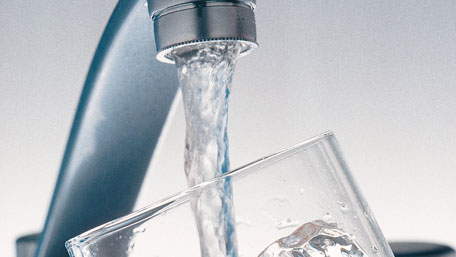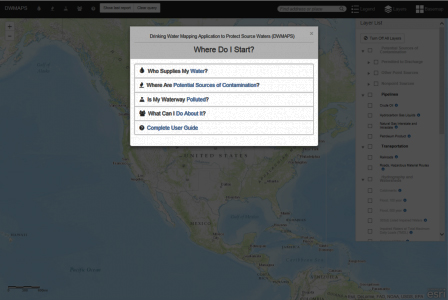Navigation
Actions to Prevent Polluted Drinking Water in the United States
[img_assist|nid=1541|title=Drinking water|desc=Courtesy of CDC|link=none|align=left|width=180|height=120]In recognition of urgent, immediate need to address devastating health problems caused by lead in drinking water in Flint, Michigan, and in other places across the United States the U.S. Environmental Protection Agency (EPA) released DWMAPS – the Drinking Water Mapping Application to Protect Source Waters on the 19th of February 2016.
 Drinking water: Courtesy of CDC
Drinking water: Courtesy of CDC
On January 16, 2016, President Obama signed an emergency declaration ordering federal assistance to support state and local response efforts in Flint, Michigan.
The U.S. Department of Health and Human Services (HHS) has been designated the lead federal agency responsible for coordinating federal government response and recovery efforts.
In collaboration with the Federal Emergency Management Agency (FEMA), HHS will identify and mobilize the capabilities of the rest of the federal partners – including the Small Business Administration (SBA), the Environmental Protection Agency (EPA), and the Departments of Housing and Urban Development (HUD), Agriculture (USDA) and Education -- that are already working to help residents in Flint.
The goal of the federal response is to help state and local leaders identify the size and scope of the problem, and work with them to make and execute a plan for mitigation of the short- and long-term health effects of lead exposure.
 Public School Children in danger of exposure to lead: Courtesy of CDC
Public School Children in danger of exposure to lead: Courtesy of CDC
March 21, 2016, a New York Times editorial drew attention to the “shocking” but not “surprising given the neglect of public schools, especially in poor communities, by Congress and state government, lead in drinking water in Newark, New Jersey, Public Schools. “Newark Public Schools recently acknowledged that the water at its schools has contained high levels of lead for years. …Public health experts say there is no safe amount of lead in water and that children exposed to the heavy metal can suffer irreversible damage to the neurological system.” As the Editorial points out, federal law does not require schools to test their water if they get it from public water utility, which most schools do.” As they write, “This needs to change.”
The lead in water “often comes from water lines and plumbing fixtures with significant amounts of lead.”
The devastating conditions in Flint highlighted the crumbling infrastructure problems across the US. As recorded by the American Society of Civil Engineers in its Report Card for America’s Infrastructure, which assigns letter grades assigning letter grades based on the physical condition and needed investments for improvement, ASCE estimate investment needed by 2020 is $ 3.6 Trillion. The United States infrastructure Report Card for 2013 gives wastewater a D and drinking water a D, dams a D, inland waterways a D-, levees a D-, and schools and roads a D.
“The American Society of Civil Engineers’ 2013 Report Card for America’s Infrastructure depicts the condition and performance of the nation’s infrastructure in the familiar form of a school report card—assigning letter grades based on the physical condition and needed investments for improvement. Available as a free tablet and phone app, you can put the most comprehensive infrastructure reference available in your pocket atwww.infrastructurereportcard.org. For more information or to request a speaker, email us.”
ASCE estimate investment needed by 2020: $ 3.6 Trillion. The United States infrastructure Report Card for 2013 gives wastewater a D and drinking water a D, dams a D, inland waterways a D-, levees a D-, and schools and roads a D.
Back on October 16, 2015, EPA established the Flint Safe Drinking Water Task Force to provide the Agency’s technical expertise through regular dialogue with designated officials from Michigan Department of Environmental Quality and the City of Flint.
Recently, on the 19th of February 2016, in recognition of urgent, immediate need to address devastating health problems caused by lead in drinking water in Flint, Michigan, and in other places across the United States, the U.S. Environmental Protection Agency (EPA) released DWMAPS – the Drinking Water Mapping Application to Protect Source Waters.
This initiative is in combination with other actions such as the formation of and, now, responses from EPA’s Flint Safe Drinking Water Task Force.
The DWMAPS online mapping tool provides the public, water system operators, state programs, and federal agencies with critical information to help them safeguard the sources of America’s drinking water.
One can, for example, check water sources around Flint. The lead levels found in children and adults, unfortunately, also comes from lead paint and lead in dust and from leaded gas, EPA Administrator Gina McCarthy said during congressional hearings about the poisonous water in Flint held this week.
DWMAPS allows users to learn about their watershed and understand more about their water supplier. DWMAPS also lets users know if sources of their drinking water are polluted and if there are possible sources of pollution that could affect their communities’ water supply.
For this article, Horizon International asked EPA “What specific contaminants are including in the maps for Flint, such as lead from the water pipes?” The EPA responded “DWMAPS provides users with the ability to look at where surface waters have been listed as contaminated for their designated use and by which contaminant. It does not however, map lead service lines. It does allow a user to view a system’s consumer confidence report and compliance history.”
DWMAPS can also guide users to ways they can get involved in protecting drinking water sources in their community.
“A key part of having safe drinking water is protecting the sources – the streams, rivers, and lakes where utilities withdraw water,” said EPA Administrator Gina McCarthy. “DWMAPS is the latest example of how EPA is using technology and digital tools to better protect public health and the environment.”
Utilities and state drinking water program managers can also use DWMAPS with their own state and local data. It allows them to identify potential sources of contamination in their locations, find data to support source water assessments and plans to manage potential sources of contamination and evaluate accidental spills and releases.
DWMAPS also integrates drinking water protection activities with other environmental programs at the federal, state, and local levels.
DWMAPS can provide users with information to update source water assessments and prioritize source water protection in any location or watershed in the country.
How can DWMAPS be used to protect sources of drinking water?
Specifically, DWMAPS helps users to:
· Identify potential sources of contamination in locations defined by users;
· Find data to support source water assessments and plans to manage potential sources of contamination;
· Evaluate accidental spills and releases, identifying where emergency response resources for accidental releases must be readily available; and
· Promote integration of drinking water protection activities with other environmental programs at the EPA, state, and local levels.
DWMAPS does not display the actual locations of
Public Water System
facility intakes but contains a wide variety
of data useful to protection of drinking water sources.
The mapping system will not display the locations of Public Water System facility intakes, but it does contain a wide variety of data useful to the protection of drinking water sources. EPA developed DWMAPS in consultation with EPA regional drinking water programs, state drinking water regulators, and public water systems.
Visit http://www.epa.gov/sourcewaterprotection/dwmaps
Guidance from the Centers for Disease Control and Prevention (CDC)
Visit http://www.cdc.gov/nceh/lead/
"Today at least 4 million households have children living in them that are being exposed to high levels of lead. There are approximately half a million U.S. children ages 1-5 with blood lead levels above 5 micrograms per deciliter (µg/dL), the reference level at which CDC recommends public health actions be initiated.
"No safe blood lead level in children has been identified. Lead exposure can affect nearly every system in the body. Because lead exposure often occurs with no obvious symptoms, it frequently goes unrecognized. CDC’s Childhood Lead Poisoning Prevention Program is committed to the Healthy People 2020goals of eliminating blood lead levels ≥ 10 µg/dL and differences in average risk based on race and social class as public health concerns. The program is part of the National Center for Environmental Health's Division of Emergency and Environmental Health Services."
http://www.cdc.gov/nceh/lead/parents.htm
http://www.cdc.gov/nceh/lead/tips/water.htm
Prevent Children’s Exposure to Lead
Guidance from the Centers for Disease Control and Prevention (CDC)
“Lead poisoning can be prevented. The key is to keep children from coming in contact with lead. If children are lead poisoned they must be treated. Learn how to prevent children’s exposure to lead.”
 Lead Poisoning Prevention Infographic: Click image to go to the Infographic
Lead Poisoning Prevention Infographic: Click image to go to the Infographic
Click here for the full lead poisoning prevention infographic. Available at http://www.cdc.gov/nceh/lead/infographic.htm.
In 2010, the CDC posted an “Important update: Lead-based Water Lines” available at http://www.cdc.gov/nceh/lead/waterlines.htm
Sources of Lead, a summary from the CDC: “A child's environment is full of lead. Children are exposed to lead from different sources (such as paint, gasoline, solder, and consumer products) and through different pathways (such as air, food, water, dust, and soil). Although there are several exposure sources, lead-based paint is the most widespread and dangerous high-dose source of lead exposure for young children.“
Additional Resources:
EPA - Drinking Water Requirements for States and Public Water Systems and information on chemical and microbial contaminants. Safe Drinking Water Hotline: 1-800-426-4791.
Search
Latest articles
Agriculture
- World Water Week: Healthy ecosystems essential to human health: from coronavirus to malnutrition Online session Wednesday 24 August 17:00-18:20
- World Water Week: Healthy ecosystems essential to human health: from coronavirus to malnutrition Online session Wednesday 24 August 17:00-18:20
Air Pollution
- "Water and Sanitation-Related Diseases and the Changing Environment: Challenges, Interventions, and Preventive Measures" Volume 2 Is Now Available
- Global Innovation Exchange Co-Created by Horizon International, USAID, Bill and Melinda Gates Foundation and Others
Biodiversity
- It is time for international mobilization against climate change
- World Water Week: Healthy ecosystems essential to human health: from coronavirus to malnutrition Online session Wednesday 24 August 17:00-18:20
Desertification
- World Water Week: Healthy ecosystems essential to human health: from coronavirus to malnutrition Online session Wednesday 24 August 17:00-18:20
- UN Food Systems Summit Receives Over 1,200 Ideas to Help Meet Sustainable Development Goals
Endangered Species
- Mangrove Action Project Collaborates to Restore and Preserve Mangrove Ecosystems
- Coral Research in Palau offers a “Glimmer of Hope”
Energy
- Global Innovation Exchange Co-Created by Horizon International, USAID, Bill and Melinda Gates Foundation and Others
- Wildlife Preservation in Southeast Nova Scotia
Exhibits
- Global Innovation Exchange Co-Created by Horizon International, USAID, Bill and Melinda Gates Foundation and Others
- Coral Reefs
Forests
- NASA Satellites Reveal Major Shifts in Global Freshwater Updated June 2020
- Global Innovation Exchange Co-Created by Horizon International, USAID, Bill and Melinda Gates Foundation and Others
Global Climate Change
- It is time for international mobilization against climate change
- It is time for international mobilization against climate change
Global Health
- World Water Week: Healthy ecosystems essential to human health: from coronavirus to malnutrition Online session Wednesday 24 August 17:00-18:20
- More than 400 schoolgirls, family and teachers rescued from Afghanistan by small coalition
Industry
- "Water and Sanitation-Related Diseases and the Changing Environment: Challenges, Interventions, and Preventive Measures" Volume 2 Is Now Available
- Global Innovation Exchange Co-Created by Horizon International, USAID, Bill and Melinda Gates Foundation and Others
Natural Disaster Relief
- STOP ATTACKS ON HEALTH CARE IN UKRAINE
- Global Innovation Exchange Co-Created by Horizon International, USAID, Bill and Melinda Gates Foundation and Others
News and Special Reports
- World Water Week: Healthy ecosystems essential to human health: from coronavirus to malnutrition Online session Wednesday 24 August 17:00-18:20
- STOP ATTACKS ON HEALTH CARE IN UKRAINE
Oceans, Coral Reefs
- World Water Week: Healthy ecosystems essential to human health: from coronavirus to malnutrition Online session Wednesday 24 August 17:00-18:20
- Mangrove Action Project Collaborates to Restore and Preserve Mangrove Ecosystems
Pollution
- Zakaria Ouedraogo of Burkina Faso Produces Film “Nzoue Fiyen: Water Not Drinkable”
- "Water and Sanitation-Related Diseases and the Changing Environment: Challenges, Interventions, and Preventive Measures" Volume 2 Is Now Available
Population
- "Water and Sanitation-Related Diseases and the Changing Environment: Challenges, Interventions, and Preventive Measures" Volume 2 Is Now Available
- "Water and Sanitation-Related Diseases and the Changing Environment: Challenges, Interventions, and Preventive Measures" Volume 2 Is Now Available
Public Health
- Honouring the visionary behind India’s sanitation revolution
- Honouring the visionary behind India’s sanitation revolution
Rivers
- World Water Week: Healthy ecosystems essential to human health: from coronavirus to malnutrition Online session Wednesday 24 August 17:00-18:20
- Mangrove Action Project Collaborates to Restore and Preserve Mangrove Ecosystems
Sanitation
- Honouring the visionary behind India’s sanitation revolution
- Honouring the visionary behind India’s sanitation revolution
Toxic Chemicals
- "Water and Sanitation-Related Diseases and the Changing Environment: Challenges, Interventions, and Preventive Measures" Volume 2 Is Now Available
- Actions to Prevent Polluted Drinking Water in the United States
Transportation
- "Water and Sanitation-Related Diseases and the Changing Environment: Challenges, Interventions, and Preventive Measures" Volume 2 Is Now Available
- Urbanization Provides Opportunities for Transition to a Green Economy, Says New Report
Waste Management
- Honouring the visionary behind India’s sanitation revolution
- Honouring the visionary behind India’s sanitation revolution
Water
- Honouring the visionary behind India’s sanitation revolution
- Honouring the visionary behind India’s sanitation revolution
Water and Sanitation
- Honouring the visionary behind India’s sanitation revolution
- Honouring the visionary behind India’s sanitation revolution


